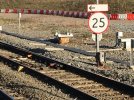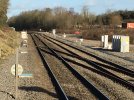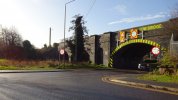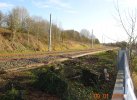Who is the authorising body for this request? Is it solely a National Grid decision?
I think so.
Who is the authorising body for this request? Is it solely a National Grid decision?
Is design work on this far advanced enough so that the teams can continue onto Wigston as soon as the work to Market Harborough is complete, without any pause?Yes, and having looked at my map it makes a lot of sense if true.
1) Nice and steady incremental electrification.
2) A bit less diesel mileage
3) Gets it past the treasury
4) Keeps teams occupied while (one assumes Leicester area remodeling takes place)
5) Well, well, well within the power capability of the Braybrooke Grid feeder
<speculation on> I hope when they do to Leicester they do to Glen Parva Jct while they are at with a nice overlap to make easier to eventually go to Nuneaton </speculation off>
we will learn how committed the DfT is to extending the wires when the feeder stations north of Braybrook get authorised and contracts let. The long lead time tasks.
Absolutely fantastic news.AIUI, the application for a connection to the National Grid for Kegworth has been made.
Who is the authorising body for this request? Is it solely a National Grid decision?
AIUI, the application for a connection to the National Grid for Kegworth has been made.
The piles that @PJM pictured from the Little Bowden footbridge (which connects Braybrooke Road and Glebe Road if you're not local) have now received the galvanised plates that I guess masts will shortly be bolted to.
Seems like plenty is going on during this set of (mostly) overnight works (dates and times of work near Harborough are in the picture posted by @Trainben in #4687)

 Ditto , north of platform 2
Ditto , north of platform 2Absolutely fantastic news.
I certainly can't speak for the details on hammering piles in, or structure locations, but I'm sure work to investigate the proposed sectioning sites at East Langton & South Wigston in advance of the installation of those sites' required equipment will begin soon if it hasn't already.Is design work on this far advanced enough so that the teams can continue onto Wigston as soon as the work to Market Harborough is complete, without any pause?
I understand but I am a "glass is half full" person so still a step in the right direction. With all the hoo-hah about IRP etc. I am very confident it will happen. Now if an application was made for Chesterfield area ------ well.....application doesn’t mean paid for, of course.
Great shots - thanks for posting.View attachment 108354View attachment 108355Ditto , north of platform 2
I understand but I am a "glass is half full" person so still a step in the right direction. With all the hoo-hah about IRP etc. I am very confident it will happen.


By the look of those supports they are going for traditional single track cantilevers, unlike the double track cantilevers used even on double track sections further south.View attachment 108441
This from Braybrooke Road about 1/2 mile South of the Station
Is nine signs of various types some kind of record for one side of one bridge?off topic but a bridge bash on that low bridge would be disruptive.
On topic - at least one new sign will surely go on -Danger Overhead Live wires or similar.Is nine signs of various types some kind of record for one side of one bridge?
Not required on a bridgeOn topic - at least one new sign will surely go on -Danger Overhead Live wires or similar.
Yeah, that wagonload looks like a mix of STCs and TTCs (Twin Track Cantilevers - which will eventually gain a boom).These pics were taken just north of Braybrooke Road this afternoon about 1.30pm, sorry about the picture quality. I got right up close to the wagon just after taking these pics, from where the skateboard park is situated, they appeared to look like double track cantilevers on it, although I could be incorrect as not too experienced in this area.
So since I have seen signs on bridges it must only have signs when a bridge goes OVER an electrified railway but not like this when an electrified railway goes over a road? Am I correct?Not required on a bridge
Thanks for the technical info 59CosG95.Yeah, that wagonload looks like a mix of STCs and TTCs (Twin Track Cantilevers - which will eventually gain a boom).
Double Cantilever masts are different; while they typically only do one track, they support 2 wire runs and are found at crossovers and overlaps.
(TTCs can also do this, but can support up to 4 wire runs over 2 tracks when used in this way.)hanks 59CosG95 ...
Thanks for posting.
off topic but a bridge bash on that low bridge would be disruptive.
Why are masonry bridges permitted to be used at low speed (with the implication that others (steel?) can't)? Is it because each brick carries only a tiny amount of the overall load, so knocking out a few doesn't really matter? Or, I'm told that Victorian era bridges (which I'm guessing this one is because it's masonry) are far stronger than they need to be, because back then they didn't really know how strong the bridges needed to be so "bigger = better"; thus, if it's knocked, it still has sufficient load-bearing capacity, compared with a modern bridge designed to be "just enough"?It used to be, but not so much now. One of the most bashed in the country. Being masonry (and assessed suitable) I’m fairly sure the line can be run at caution until assessed by a competent person. Ie trains can move, so are delayed maybe 5-10 minutes.
Why are masonry bridges permitted to be used at low speed (with the implication that others (steel?) can't)? Is it because each brick carries only a tiny amount of the overall load, so knocking out a few doesn't really matter? Or, I'm told that Victorian era bridges (which I'm guessing this one is because it's masonry) are far stronger than they need to be, because back then they didn't really know how strong the bridges needed to be so "bigger = better"; thus, if it's knocked, it still has sufficient load-bearing capacity, compared with a modern bridge designed to be "just enough"?
Ok, thanks!Essentially, metal bridges need some flexibility to deal with expansion, and therefore can be dislodged (complete) or bend more easily than masonry.
Thanks very much @PJM! I can make out a 5th TTC mast in the first 2 pictures, clearly planted on the Up side, in the distance.View attachment 108500
Looking north from the footbridge at Little Bowdon/Glebe Road towards Market Harborough station today.View attachment 108502View attachment 108501
and looking south.
Yes, that one is by ATS Tyres, just North of Kettering RoadThanks very much @PJM! I can make out a 5th TTC mast in the first 2 pictures, clearly planted on the Up side, in the distance.
In an arched bridge the forces are compressive. Brick, stone and concrete are very good at carrying compressive loads. Arched bridges can last for centuries with minimal maintenance but are not suitable for longer spans.Why are masonry bridges permitted to be used at low speed (with the implication that others (steel?) can't)? Is it because each brick carries only a tiny amount of the overall load, so knocking out a few doesn't really matter? Or, I'm told that Victorian era bridges (which I'm guessing this one is because it's masonry) are far stronger than they need to be, because back then they didn't really know how strong the bridges needed to be so "bigger = better"; thus, if it's knocked, it still has sufficient load-bearing capacity, compared with a modern bridge designed to be "just enough"?
Why are masonry bridges permitted to be used at low speed (with the implication that others (steel?) can't)? Is it because each brick carries only a tiny amount of the overall load, so knocking out a few doesn't really matter? Or, I'm told that Victorian era bridges (which I'm guessing this one is because it's masonry) are far stronger than they need to be, because back then they didn't really know how strong the bridges needed to be so "bigger = better"; thus, if it's knocked, it still has sufficient load-bearing capacity, compared with a modern bridge designed to be "just enough"?
In an arched bridge the forces are compressive. Brick, stone and concrete are very good at carrying compressive loads. Arched bridges can last for centuries with minimal maintenance but are not suitable for longer spans.
Steel is good at both compressive and tensile loads but you wouldn't make an arched bridge out of solid steel - it would be too heavy, too expensive and not an economical use of the material.
